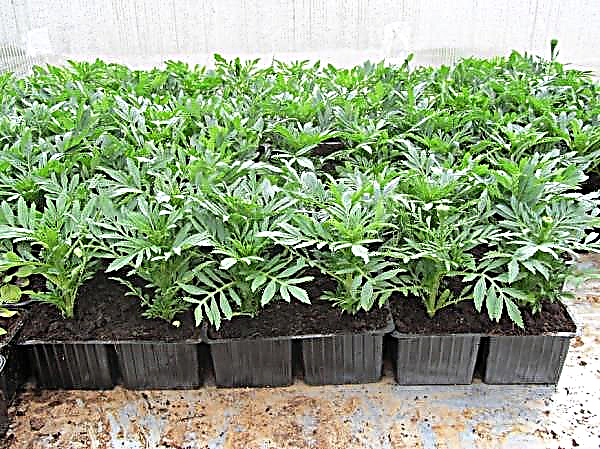Gladiolus (or skewer) can be found in many garden plots. It not only adorns flower beds with lush flowering, but also has a valuable composition, bringing great benefits to the human body. All parts of the plant are used in folk medicine, contributing to the treatment of various ailments. The botanical characteristics of gladiolus, the benefits and harms of a flower, as well as methods for its use as a medicine, are further described in the article.
Description of gladiolus
The birthplace of gladiolus (Latin: Gladiolus) is Africa, and in Europe this flower began to be grown only in the 16th century. Today, many varieties of plants that are grown around the world are bred.
Did you know? The scientific name of the flower comes from the Latin word "gladius", which meant a short Roman sword.
Botanical description of gladiolus:
- The flower belongs to perennial ornamental plants of the Iris family.
- In the lower part of the stem is a corm, formed by thickening of the lower leaves of the plant. It has a round shape and the outside is covered with thin scales of white or dark color. The diameter of the corm is up to 15 cm.
- The root system of the flower consists of two tiers. The first is located on the bottom of the corm and is a filiform processes up to 30 cm long. The second tier is located in the phase of the third leaf, contains roots of different lengths and thicknesses.
- The stalk is straight, strong due to the bases of leaves closing around it. Its height is up to 1.5 m.
- Leaf plates of a plant can reach a length of 80 cm, and their width is 2–7 cm. They are straight, and in shape resemble the tip of a sword. On each gladiolus grows about 7-12 green leaves with a bluish tint.
- The peduncle is a section of the stem located above the last leaf. On it is an inflorescence in the form of an ear, consisting of 16-24 flowers.
- The length of the inflorescence can reach 80 cm. Flowers in it can be arranged in rows, in a spiral or on both sides (depending on the variety).
- Flowering lasts from 3 to 7 days. Early varieties of plants bloom in late July, and later in mid-September.
- The flower consists of large petals. Their shape, density and color depend on the variety of the plant. Petals can be plain, spotty, two-tone, with a border and strokes.
- The gladiolus flowers are bisexual, contain 3 stamens and 1 pestle, which has a three-bladed stigma. Pollinators are insects - bumblebees.
- After flowering is completed, a fruit is formed on the plant - a small tricuspid box. It contains up to 200 round brown seeds up to 2 mm in size.

The benefits and harms of plants
In addition to its attractive appearance, gladiolus has many useful properties that are due to the rich chemical composition of the flower. The plant contains a large amount of vitamin C, healing essential oils, starch and sugar.
- The use of skewer has such a positive effect on a person:
- relieves inflammation;
- destroys microbes;
- stimulates wound healing;
- helps to eliminate pain;
- strengthens the immune system;
- prevents the development of malignant tumors;
- improves the functioning of the digestive system;
- increases sex drive in men;
- eliminates problems with urination;
- helps to cleanse blood vessels;
- strengthens the immune system;
- stimulates the production of breast milk during lactation;
- It has a rejuvenating effect on the skin.
Despite the large number of useful properties, bulbs and leaves of gladiolus are a strong allergen, so they should be used with caution. If you have any diseases, it is recommended to consult with your doctor first.
Important! You need to start using gladiolus with a small dose, observing the body's reaction to the product.
Application in traditional medicine
Useful properties of fenders were known to traditional healers back in the 17th century. Since that time, the plant has been widely used for the preparation of medicines according to traditional medicine recipes. Today they can be used as natural analogues of pharmacy tablets and syrups, therefore they are used to treat colds, relieve toothache, increase lactation in nursing women and strengthen male strength.
Today they can be used as natural analogues of pharmacy tablets and syrups, therefore they are used to treat colds, relieve toothache, increase lactation in nursing women and strengthen male strength.
Toothache
Skewer bulbs contain substances that help relieve toothache. They make healing poulticesthat are applied to the affected area in the oral cavity and held until the discomfort is eliminated. In this case, the onion must be washed and chopped to the state of gruel, and then pour boiling water for 1-2 hours (about 1 ml of water will require about 200 ml of water per 1 tbsp.). The resulting mixture is impregnated with a cotton or gauze swab, and then applied to a diseased tooth.
Important! With severe toothaches, you can change the poultice, applying fresh every 20-30 minutes.
From a cold
During colds, which is accompanied by a runny nose, juice of leaves of the skewer is often used. It facilitates breathing and stimulates the outflow of mucus from the nasal cavity.
To treat a runny nose with gladiolus, you need to:
- Rinse several leaves of the plant, grind them to a state of gruel.
- Add the resulting mass into cheesecloth and squeeze the juice.
- Prepare small pieces of gauze or cotton wool. Twist them in the form of a tourniquet (in size it should fit in the nostril).
- Dip each obtained tourniquet into gladiolus juice, and then insert them one at a time into each nostril.
- Hold until copious discharge of mucus from the nose begins, and then remove.
Repeat the procedure as necessary until the common cold disappears.
For male potency
In the second year of growing gladiolus, small daughter bulbs form on top of the mother tuber. They have long been used as a natural aphrodisiac for men. To enhance potency, it is enough to eat one such daughter onion and drink it with a small amount of red wine.
The use of maternal corms of the skewer has the opposite effect and leads to a decrease in sexual desire in men. To reduce potency, you can prepare a salad from this part of the plant or eat it separately with tea.
For weight gain
Many women use special diets not only for losing weight, but also for gaining the missing pounds. This goal can be achieved with the help of a fennel bulb.
You can increase body weight and improve complexion using this recipe:
- Wash the bulb of the plant, grind it to a pulp consistency.
- Put 3 g of the resulting mass in a glass, pour a small amount of fruit water (you can not use juice).
- Insist remedy for an hour. Use the resulting amount of the drug 1 time per day until the desired result is achieved.
Lactating women
A healing broth is prepared from the fennel bulbs, which helps to establish the production of breast milk in lactating women.
Did you know? In ancient Greece, gladiolus was considered a weed, and its milled onions were added to the dough, from which cakes were baked.
The recipe for its preparation is presented below:
- Rinse the gladiolus bulbs, finely chop them with a knife.
- In a stewpan put 2 hours of the resulting raw material, pour 2 tbsp. pure water.
- Put the container on medium heat, bring to a boil.
- Boil the mixture for about 7 minutes, and then let it brew in a thermos for 2 hours.
Broth drink 2 tbsp. 4 times a day before meals until regular production of breast milk is established.
Contraindications
Modern medicine recognizes gladiolus as an absolutely safe plant. The only contraindication for the use of bulbs and leaves is an individual intolerance to the product, as well as an increased tendency to allergies. If you feel worse as a result of using gladiolus, it is recommended to immediately stop using the plant and consult a doctor.
Medicines from bulbs and leaves of gladiolus help to improve the well-being of a person and the general condition of the body in various diseases. Using the listed recipes, you can easily cook them yourself at home. But in order to avoid the occurrence of allergies, it is better to first consult a doctor.












